

Earth Optics Video 3: Fast & Slow Ray. 2.7 Properties Under Cross Polarized Light – Introduction to Petrology. In this section, we explore properties that can be observed for minerals under cross polarized light, when both the lower polarizer and the analyzer (top polarizer) are inserted into the polarizing light microscope.
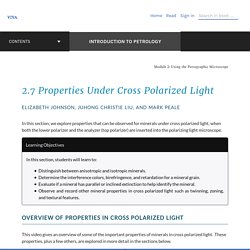
In this section, students will learn to: Distinguish between anisotropic and isotropic minerals.Determine the interference colors, birefringence, and retardation for a mineral grain.Evaluate if a mineral has parallel or inclined extinction to help identify the mineral.Observe and record other mineral properties in cross polarized light such as twinning, zoning, and textural features. This video gives an overview of some of the important properties of minerals in cross polarized light. These properties, plus a few others, are explored in more detail in the sections below. Figure 2.7.1. Isotropic minerals have crystal structures which have the same structure in every direction.
Figure 2.7.4. The color of a mineral under cross-polarized light is called its interference color. Untitled. Molecular Expressions Microscopy Primer: Specialized Microscopy Techniques - Polarized Light Microscopy Gallery - Olivine Pyroxene Andesite. Polarized Light Microscopy Digital Image Gallery Olivine Pyroxene Andesite Andesite is a type of finely crystalline rock of volcanic origin that typically consists of andesine or another plagioclase feldspar and one or more ferromagnesian minerals, such as pyroxene and olivine.

This type of rock, which is common in the Andes Mountains from whence it gains its name, typically occurs in porphyries, large crystals of the feldspar or dark minerals it contains jutting out of a fine-grained matrix. View a second and third image of Olivine Pyroxene Andesite Comprising an important group of rock-forming minerals, olivines are common components of magnesium-rich, silica-poor igneous rocks.
Similar to olivine, pyroxene does not refer to a single mineral, but rather to a diverse group of silicate minerals. Questions or comments? This website is maintained by ourGraphics & Web Programming Team in collaboration with Optical Microscopy at theNational High Magnetic Field Laboratory. Minerals, geology, metamorphic rocks. Video atlas of minerals in thin section. This is a growing collection (now over 1000 videos highlighting close to 270 samples) of short (~30s each) videos showing a variety of both common and rare minerals in thin section through 360° rotations.
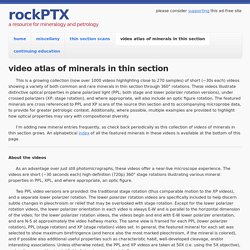
These videos illustrate distinctive optical properties in plane polarized light (PPL; both stage and lower polarizer rotation versions), under crossed polarizers (XP; stage rotation), and where appropriate, will also include an optic figure rotation. The featured minerals are cross referenced to PPL and XP scans of the source thin section and to accompanying microprobe data, to provide for greater petrologic context. Additionally, where possible, multiple examples are provided to highlight how optical properties may vary with compositional diversity. I’m adding new mineral entries frequently, so check back periodically as this collection of videos of minerals in thin section grows.
Inosilcates. Hornblende porphyrite - Valparaiso. Teaching Mineralogy and Petrology Online. Tectosilicates and miscellaneous silicates in thin section. Check out the video atlas of minerals in thin section introduction page for some background on how these videos were prepared and processed, and for additional useful information on the included table content, the search tab, and other user-adjustable features.

There is also an accompanying illustration to assist viewers with determining 2V° values from the BxA or optic axis figures in the “optic figures” videos. Note: Despite the videos being externally linked, depending on the speed of your internet connection, it could still take a minute or two for the full table to load. To preview or play a video here at the featured thumbnail scale, click the gray play button (which turns blue when you hover over it).
Move the cursor off the video and after a few seconds the play button will be hidden. Phyllosilicates in thin section. Check out the video atlas of minerals in thin section introduction page for some background on how these videos were prepared and processed, and for additional useful information on the included table content, the search tab, and other user-adjustable features.
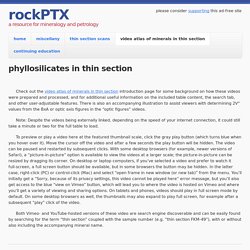
There is also an accompanying illustration to assist viewers with determining 2V° values from the BxA or optic axis figures in the “optic figures” videos. Note: Despite the videos being externally linked, depending on the speed of your internet connection, it could still take a minute or two for the full table to load. To preview or play a video here at the featured thumbnail scale, click the gray play button (which turns blue when you hover over it). Move the cursor off the video and after a few seconds the play button will be hidden. The video can be paused and restarted by subsequent clicks. Double chain and more complex inosilicates in thin section. Single chain inosilicates in thin section. Check out the video atlas of minerals in thin section introduction page for some background on how these videos were prepared and processed, and for additional useful information on the included table content, the search tab, and other user-adjustable features.

There is also an accompanying illustration to assist viewers with determining 2V° values from the BxA or optic axis figures in the “optic figures” videos. Note: Despite the videos being externally linked, depending on the speed of your internet connection, it could still take a minute or two for the full table to load.
To preview or play a video here at the featured thumbnail scale, click the gray play button (which turns blue when you hover over it). Sorosilicates and cyclosilicates in thin section. Check out the video atlas of minerals in thin section introduction page for some background on how these videos were prepared and processed, and for additional useful information on the included table content, the search tab, and other user-adjustable features.
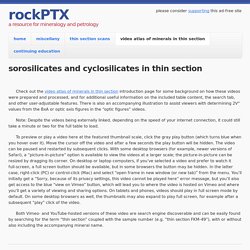
There is also an accompanying illustration to assist viewers with determining 2V° values from the BxA or optic axis figures in the “optic figures” videos. Nesosilicates in thin section. Check out the video atlas of minerals in thin section introduction page for some background on how these videos were prepared and processed, and for additional useful information on the included table content, the search tab, and other user-adjustable features.
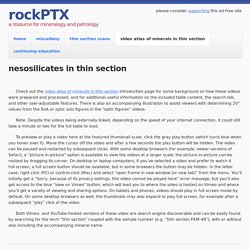
There is also an accompanying illustration to assist viewers with determining 2V° values from the BxA or optic axis figures in the “optic figures” videos. Note: Despite the videos being externally linked, depending on the speed of your internet connection, it could still take a minute or two for the full table to load. To preview or play a video here at the featured thumbnail scale, click the gray play button (which turns blue when you hover over it).
Move the cursor off the video and after a few seconds the play button will be hidden. The video can be paused and restarted by subsequent clicks. Non-silicates in thin section. Check out the video atlas of minerals in thin section introduction page for some background on how these videos were prepared and processed, and for additional useful information on the included table content, the search tab, and other user-adjustable features.
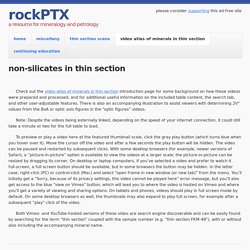
There is also an accompanying illustration to assist viewers with determining 2V° values from the BxA or optic axis figures in the “optic figures” videos. Note: Despite the videos being externally linked, depending on the speed of your internet connection, it could still take a minute or two for the full table to load. To preview or play a video here at the featured thumbnail scale, click the gray play button (which turns blue when you hover over it). Move the cursor off the video and after a few seconds the play button will be hidden. Video atlas of minerals in thin section. Digital books.
After many months of hardcore petrography, trying to take the most informative and yet aesthetically-pleasing photomicrographs, verifying uncertain end-member compositions on the microprobe, and compiling and hand-typing in data from a wide variety of sometimes contradictory sources, the fruit of my labor of love is finally finished: the minerals from my Petrography of Exotic Rocks seminar are all together (in 3 volumes) in a new e-book series available online from the Apple iBooks Store.

This series is a photographic atlas of minerals viewed by transmitted light microscopy. Divided into the three optical classes (isotropic, uniaxial, and biaxial… a function of crystal system, of course), each volume features tabulated optical and ancillary physical properties of both common and rare species, information on distinguishing characteristics and similar species, as well as accompanying full-color, high resolution images taken under both plane-polarized light and crossed polarizers. Essentials of Igneous and Metamorphic Petrology - B. Ronald Frost, Carol D. Frost - Google Books. Clastic Thin Sections - SEPM Strata. Introduction We need contributions from SEPM members and others but to start you on your way we suggest that you visit web sites that link to petrographic educational materials.
These can be tracked down using Wikipedia, the free encyclopedia or Google? Here are some we found! An atlas site designed to aid undergraduate instruction at the Geology Department of the University of North Carolina with thin section photomicrographs and descriptions of 39 minerals, 20 plutonic textures, 14 volcanic textures, and 21 metamorphic textures. The user can switch between plane-polarized light and cross-polarized light view in selected images.Atlas of Coals 231 photomicrographs of coals, cokes, chars, carbons, and graphite assembled by Professor John Crelling of Southern Illinois University at Carbondale. Michael W. View PDF. Wilson Cycle Summary - SEPM Strata. Summary of the Wilson cycle The Wilson Cycle begins in Stage A with a stable continental Craton.
A hot spot rises up under the Craton, heating it, causing it to swell upward, stretch and thin like taffy, crack, and finally split into two pieces. This process not only splits a continent, it also creates a new divergent plate boundary (see Rift Model). In Stage B, the one continent has been separated into two continents, east and west, and a new ocean basin (the Ophiolite Suite) is generated between them. Gypsum: Mineral information, data and localities. OFR 03-471: Science Language for Geologic-Map Databases in North America: A Progress Report. Digital Mapping Techniques '03 — Workshop Proceedings U.S. Geological Survey Open-File Report 03–471 Science Language for Geologic-Map Databases in North America: A Progress Report By North American Geologic-Map Data Model Science-Language Technical Team1 A standardized language to classify and describe earth materials and their genesis is needed because producers and consumers of geoscience information use names, terms, and icons to communicate information about geologic objects and concepts.
To the extent possible in a world of words, standardized terminology is useful to facilitate information exchange. Earth material Igneous material Hypabyssal rock Plutonic rock Plutonic Hypabyssal Volcanic rock.
Igneous. Metamorphic. Rocks in Hand Specimen - Index. Rocks under the Microscope - Index. An introduction to minerals and rocks under the microscope: View as single page. Examples. Phases. Phyllosilicates (Silicate Sheets) DATE DUE: Name: Instructor: Ms. Terry J. Boroughs Geology 305 ATOMS, ELEMENTS, AND MINERALS Instructions: Read each question carefully before selecting the BEST answer. Use GEOLOGIC VOCABULARY where APPLICABLE! More information Essentials of Geology Essentials of Geology David Sallee Minerals: Building Blocks of Rocks Chapter 2 Matter-What is it and What Does it Consist of? More information More information Geo 101 (Minerals - Unit 2) - A mineral is: 1. CE31540 Petrology Lab. Rocks Under a Microscope.
Research. Library & Charts. Minerals and Rocks. Thin sections minerals & volcanic microtextures. ALEX STREKEISEN-Basalt- A basalt is a fine-grained basic igneous rock containing essential calcic plagioclase feldspar and pyroxene (usually Augite), with or without olivine. Lectures. Optical Mineralogy and Petrography. David W. Mogk, Dept. of Earth Sciences, Montana State University This webpage provides a compilation of on-line instructional resources and teaching activities related to Optical Mineralogy and Petrography. Thin_section_microscopy.